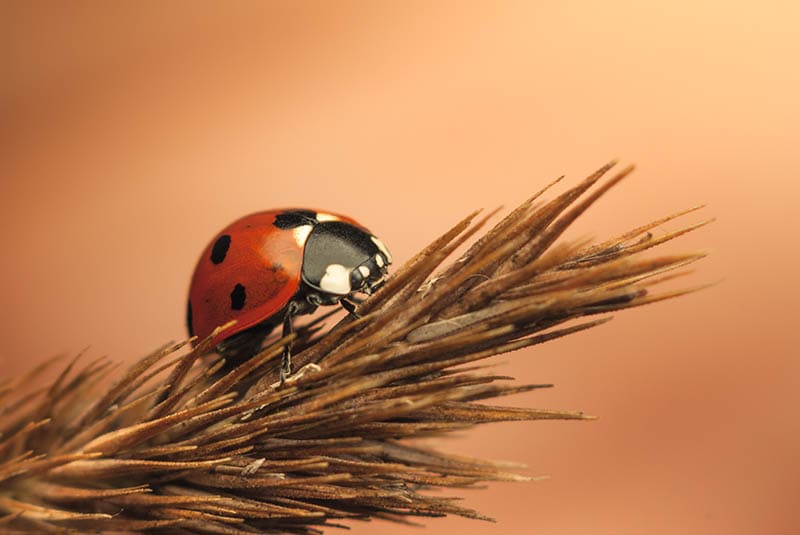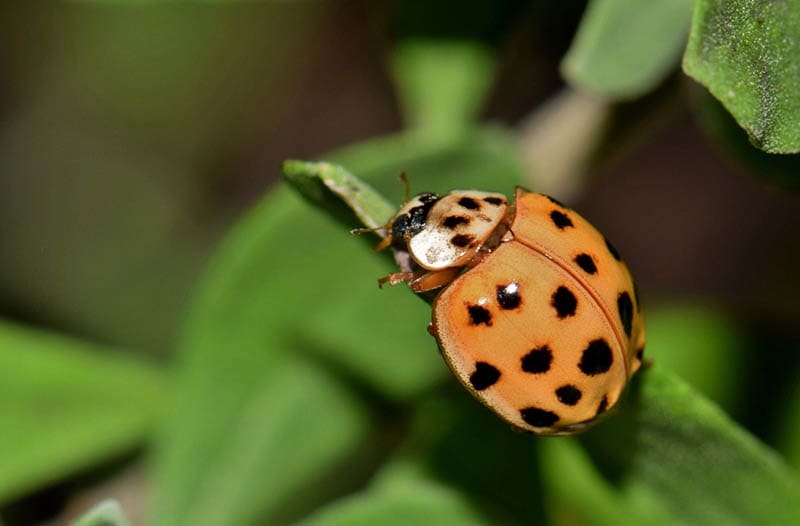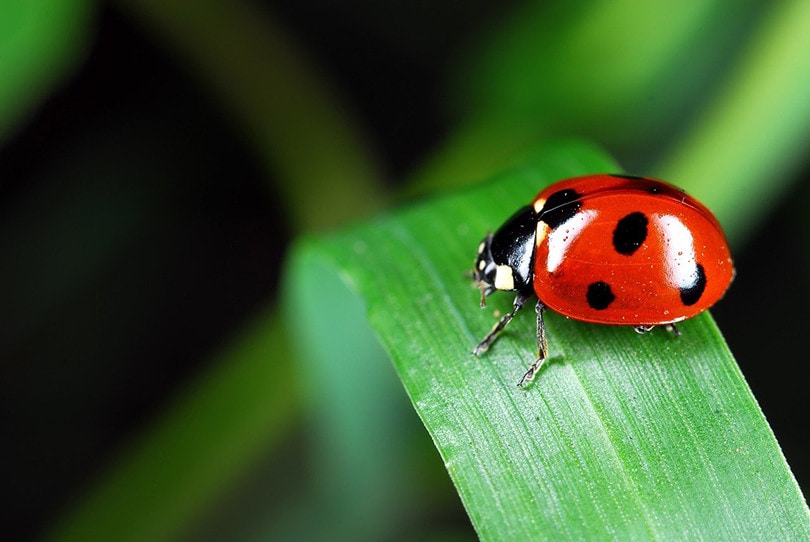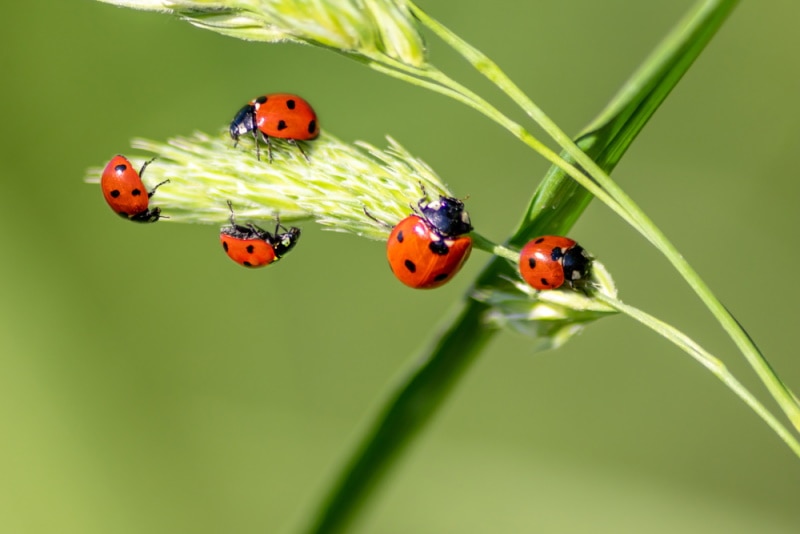12 Incredible Ladybug Facts: History, Colors, & Patterns
-
- Last updated:

There are thousands of insects and critters in our environment, and often we need to pay more attention to them. However, many people find ladybugs cute and colorful bugs, and others think of them as a lucky charm. Did you know that they are not really bugs but beetles? These are just two examples of the incredible facts you may not know about ladybugs.
So, keep reading to learn some interesting things about these fascinating little beetles.

The 12 Ladybug Facts
1. Ladybugs Come in a Variety of Colors and Patterns

If you think ladybugs are only red with black spots. You are mistaken. There are a wide range of colors and patterns in the ladybug family. The colors can range from metallic blue to ash gray and brown. When it comes to patterns, they can be dots, squiggles, and stripes.
Ladybugs can be solid with no markings at all. The harlequin ladybug will have anywhere from zero to 22 spots, and the body can be any combination of black, yellow, and red.
2. The Ladybug’s Colors Are a Warning Sign
Like the white stripe of a skunk warns us of the risk of being hit with a foul-smelling spray, ladybugs defend themselves from predators with their colors too. The toxicity will be stronger in ladybugs that have brighter colors. The predators heed the warning of the bright colors and avoid eating the foul-tasting insect.
The effect is like the warning of the bright white stripe on the center of a skunk’s back or the vibrant colors of the coral snake.
3. Ladybugs Are Not Bugs

Many entomologists will refer to ladybugs as “lady beetles” or Coccinellids because they belong to the beetle family and are not really bugs. Bugs like cicadas and bedbugs belong to the Hemiptera order, while ladybugs are part of the largest insect order known as the Coleoptera order.
4. Ladybugs Are Called by Other Names
So many different names for such a small beetle. Locals in some parts of England refer to the little lady as the Lady cow or Ladybird. Ladybird was followed by ladybug.
Lady cow and cow lady was the first name to be given to the colorful girl. In Russia, the ladybug is referred to as bozhya korovka, which means “God’s little cow,” and the word vache a’dieu was the name used by the French, which translates to “cow of God.”
5. The Different Names Were Linked to Virgin Mary

For many, the ladybug was considered a gift from above. That is why some of the names given to the beetle are linked back to Virgin Mary or God. The actual reason for this is unknown, but the theory is that the red shell of the ladybug is like Mary’s red cloak, which is seen in many religious paintings.
Another theory is based on an old European legend that suggests that the beetles were sent to farmers by the Virgin Mary to save their crops from invasive pests.
So, even if they are all called “ladies”, they are not all females. Yes, there are male ladybugs too.
6. Ladybugs Lay Extra Eggs for Their Young
Ladybug females will lay as many as one thousand tiny gold eggs in one season. Not all of them are fertile, so they do not develop an embryo. They are a tasty treat that is gifted to the newly hatched larvae from their mom. They will also lay infertile eggs to feed their offspring when food is in short supply.
While ladybugs would rather lay eggs on aphid-infested leaves, if they are not available, they will feast on the larvae and eggs.
7. Ladybugs Have Hidden Wings

It’s the attractive dome-shaped outer shell of the ladybug that protects its forewings. Beneath that outer shell, there are a pair of thin hind wings that are much larger than the body of the ladybug and will unfold in 0.1 seconds. When the ladybug unfolds these wings, they can move at about 85 beats per second.
These hidden wings do not appear until the ladybug is in the final stage of metamorphosis and becomes an adult.
8. The Larvae Looks Like an Alligator
As humans, we may imagine that ladybug larvae are cute and colorful like adult ladybugs. That is not the case, however. Ladybug eggs, when they hatch, look like alligators.
To some, the larvae may look a bit scary, but they are harmless. During this time, they will crawl, feed, and grow. They will settle on some preferred vegetation and transform into ladybug pupa and begin the process of changing into adult ladybugs.
9. Ladybugs Are Great for Pest Control

Yes, ladybugs are great for your garden. They are not only cute and colorful, but they also have huge appetites. Ladybugs are known to eat as many as 5,000 aphids in their lifetime. Gardeners are particularly fond of ladybugs because they will feast on aphids, mealy bugs, and scale bugs.
There are also ladybugs that will feed on other plant foods like pollen and others that will only feed on fungi and vegetation. For instance, the squash beetle will eat pumpkin, squash, and cantaloupe, and the Mexican bean beetle will only munch on beans. But, when it comes to mildew, the orange ladybug will be the first to the table.
10. We Are Spreading Ladybugs Worldwide
With a reputation for being excellent for pest control, it is no wonder that they are being brought over to kill pests in agricultural areas. They have also been known to stow away in boats and planes carrying imported goods.
In some cases, spreading the beetle has not been beneficial. For instance, the harlequin ladybug has spread to North America and parts of Europe from East Asia. It has been known to eat native species or infect them with deadly parasites.
11. The Harlequins are Wine Tainting Ladies

Did you ever hear of “ladybug taint?” It is a strange problem that winemakers encounter with ladybugs.
Yes, harlequin ladybugs are known to give off a stink when they are frightened. So, let us explain.
Since many vineyards are located near fields containing other crops like soybeans, for instance, the colorful beetles will make their way to the vineyards when all the nearby crops are harvested or the aphids are all gone.
As the grapes are harvested, the ladybugs will get scooped up with the grapes, get frightened, and release the stinky fluid. The result is a wine that has a stinky flavor that is likened to asparagus or peanuts. YUM!
12. Adult Ladybugs Can Survive the Winter
Have you ever rustled a bunch of leaves during the frigid winter months and noticed a pile of ladybugs all snuggled together? That is because they rest in groups under leaves or snuggle in logs during the colder months so they can survive the elements.
Some species, like the Harlequin, will enter your home to stay warm and cozy. They will nestle in large numbers into the dark cracks and crevices in your home. If your home is unusually warm, they may come out and busy themselves around the room. And while they do not damage your things or eat your food, they do spray their stink for protection which can leave a stain on light-colored surfaces.

Conclusion
So, there it is! Ladybugs are not just those cute little insects in your surroundings. In fact, they are not insects; they are beetles. In most cases, they are just cuter than the average big black beetle that make many of us feel squeamish. Hope you enjoyed reading these 12 incredible facts about ladybugs or beetles!
Featured Image Credit: Marek Piwnicki, Pexels
Contents

